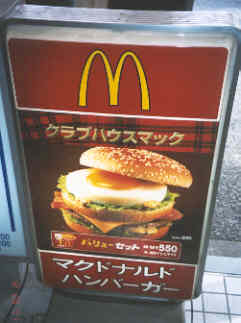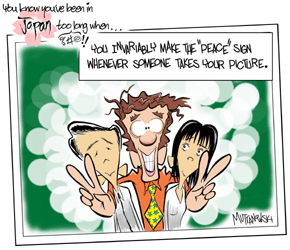![]()
![]()
Back to Japan Intro.
![]()
Back to Japan Intro
![]()
Back to Japan Intro
![]()
Back to Japan Intro
![]()
Back to Japan Intro
![]()
![]()
Useful Words, Phrases and
Gestures
The Japanese are quite appreciative of any effort a gai jin (foreigner) makes to try to speak Japanese. If one ever gets out a couple of sentences, any Japanese people listening would quickly compliment you - partly, of course, it is the culture (see "Personal Relationships"). However, it is partly a recognition of the fact that, outside of Japan, most people don't speak the language. Written Japanese is very difficult to learn.
The following are the words my wife and I found most useful in Japan:
|
hai |
*Note: No one really uses "sayonara", which everyone in the West knows as "goodbye", as it implies that they won't see you again.
|
happy ---------------------------- father (dad)----------------------- daughter ------------------------- mother (mom)-------------------- |
gen ki |
The Japanese have a phrase said before and after meals that, although not a religious saying, does give thanks for the meal:
|
prior to eating ("May I begin/looks great")-- after eating ("That was a treat/good food")- |
ita da ki mas |
|
delicious --------------------------------- great!------------------------------------- like -------------------------------------- favourite --------------------------------- welcome (heard as you enter businesses)- hot towel given at beginning of a meal---- green tea ------------------------------- any eating place (has plastic food in window)- a pub ------------------------------------ a restaurant where you cook own food - fried noodles (in above restaurant)------- restaurant serving grilled skewers of chicken fish fried in a fluffy batter----------------- bowls of noodles in a meat broth--------- dumplings with fried veggies & pork------ raw fish served in small bits -------------- Japanese horseradish root---------------- sweet rice that is firm and elastic--------- soup made of fermented soybeans & salt - |
oy shee |


|
a bad thing (a "no-no" / "faux pas") ----- difficult -------------------------------- different ------------------------------- same ---------------------------------- |
da may |
|
heated table under which you sit ---------- reed mats covering the floor -------------- |
katatsu |
*Note: Rooms in Japan often are referred to by the
number of tatame mats to give their size.

|
cute ----------------------------------- beautiful ------------------------------- fun ------------------------------------ foreigner ------------------------------ English -------------------------------- I don't understand --------------------- Let's go!------------------------------- Don't worry --------------------------- Japanese cartoon stories read by all --- |
ka wa ee |
It's the sound of the language that's really important - it's musical. I've noticed that Jackie's English has even changed.
Gestures
It is best not to use hand or other gestures as you might mistake the correct meaning of the signal or use them at inappropriate times. The following is a short list so you are aware of some signs of communication between the Japanese.
- "me"--> pointing to one's nose or touching the nose.
- "listening"--> nodding one's head up and down -- this should not be mistaken with a "yes" gesture. It means that one is listening, not necessarily agreeing.
- "negative"--> fanning one's hand back and forth in front of the face as if to nod "no" with the hand or fan away flies.
- "embarrassment"--> covering the mouth with a hand, usually by women.
- "anger"--> pointing the index fingers up from the temples - mimicking a devil with horns.
- "money" --> forming a circle with the thumb and index fingers together - similar to what is sometimes used in the West to mean "OK".
- "eating"--> holding an imaginary rice bowl in the left hand while pretending to shovel rice into the mouth with the other.
- "drinking"--> miming the wrist action of taking a drink from a small sake cup.
- "come here"--> waving the hand in a back and forth motion with the fingers pointed downwards.
©A. Appel, 2001